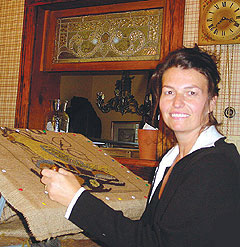|
Historically, rug-hooking was a traditional homecraft going back hundreds of years. It more or less fell from fashion in the early 1900s once the world fell in love with machine-made products. Then, in the 1950s, there was a resurgence of popularity for hooking rugs, especially among older rural women. Nowadays women of all ages and walks of life are beginning to enjoy this peaceful, relatively easy and very rewarding craft.
The work of “making them” is not difficult, Lesar-Kumer says. It is a simple matter of cutting wool into quarter-inch strips, laying a patch of burlap out, drawing a design on it and then pulling the wool up through the burlap in line with the design. Maybe it is not altogether as simple as it sounds.
Although the work is time consuming and occupies a great deal of space in the family home, the results are rugs that flatter any interior, complement antique or contemporary design and are, every one, unique.
Early on, she discovered that her rugs are easy to sell. In fact, they are sold in a shop called Renaissance in Erin, where the demand for them is as much as Lesar-Kumer can produce.
Whenever possible, Lesar-Kumer uses wool from old or vintage clothing. She finds the colours more varied and interesting than in new wool. Using old clothing also gives the rugs a vintage look that suits their style so well, she says. As it is, she has to buy her new wool from mills in the U.S.
“There are no more woollen mills in Canada,” Lesar-Kumer says. It is strange to think of that when such mills were the very fabric of industry for the early settlers in this area.
Although the rugs she creates from her own ideas sell well, she is also happy to do commissions. Of these, the biggest and most challenging was the family rug she did for the Warburtons in Hockley Valley. A large piece which now dominates their living room, the Warburton rug depicts their straw bale house, along with pictorial representations of all that is important to the family — their animals, gardens and so forth.
Lesar-Kumer says this six-month project forced her to use colours that she normally would not have because they were what the Warburtons wanted. There were many challenges to the rug, but they were “welcomed challenge,” she says. “A commission like this one makes me stretch myself and introduces me to new ideas. It is a way of expanding my own repertoire. Now I find myself using the colours I put into the Warburton rug.
While pre-designed patterns are available for hooked rugs, Lesar-Kumer prefers to work from her own designs. She does note that a person wanting to use ready-made designs could always add to them or take something away to make the pattern their own.
Lesar-Kumer has recently been enjoying a study of international designs, which bring some influence on her work. Currently, she is learning something about Russian art work, its intricacy of details and use of vibrant colours. To achieve a lot of detail, Lesar-Kumer says the wool can be cut into narrower strips, when it begins to look a little like needle point.
However, Lesar-Kumer prefers to use wide strips. “It makes for a more casual appearance,” she explains. “The rugs can accommodate any style; they lend themselves to everything. I do like to mix my styles.”
Of the strong support her family gives the art, Lesar-Kumer is full of praise.
“There is a large part of house space dedicated for the rug making. The Warburton rug took up the whole dining room for a half a year. We didn’t do much entertaining,” she jokes. “My kids love the rugs. They each have one that I made just for them.”
With no two rugs the same size or design, when the ideas for them just “come out of nowhere,” Lesar-Kumer has seemingly embarked on a lifetime of creating simple little rugs for warmth and beauty. And that suits her just fine
|

